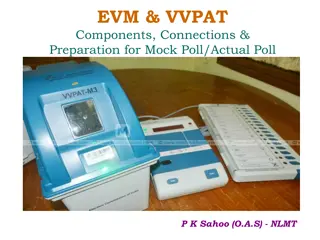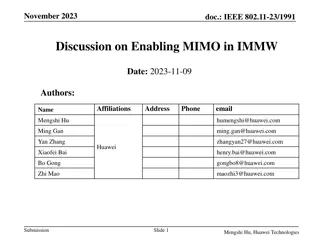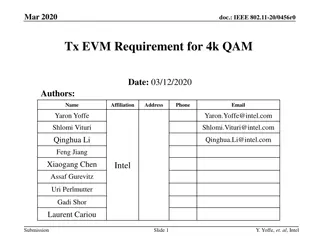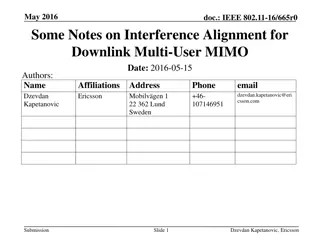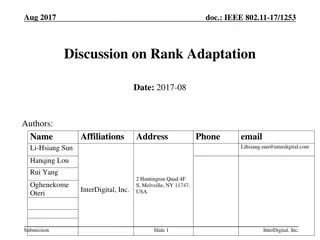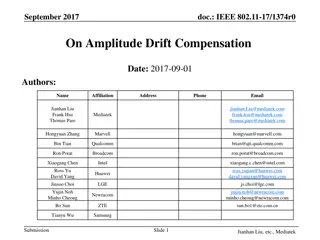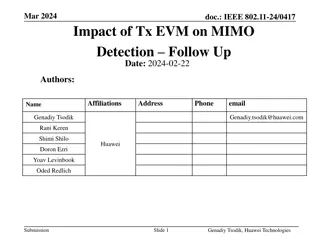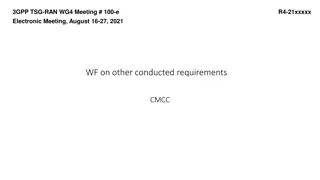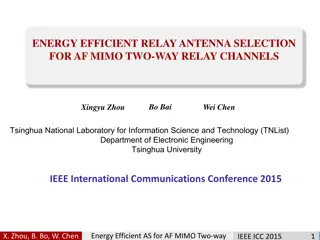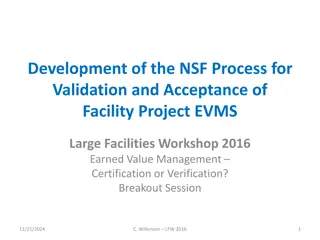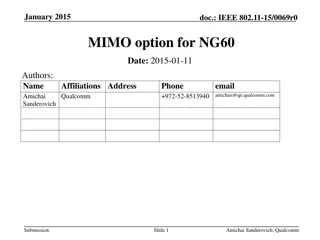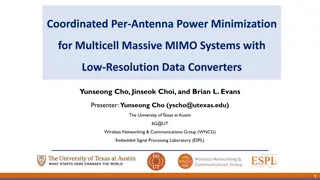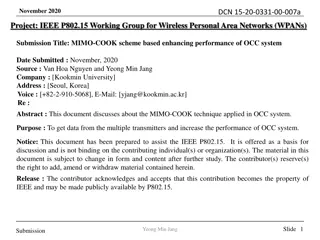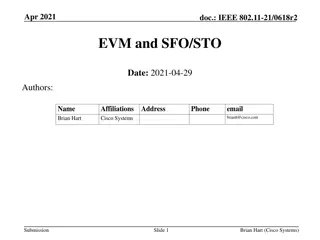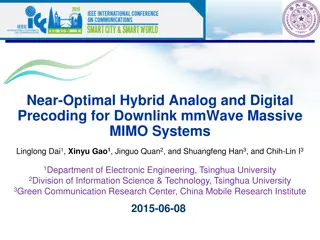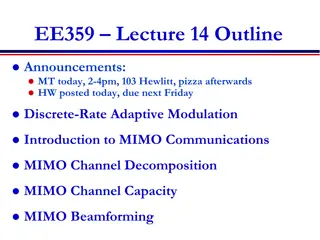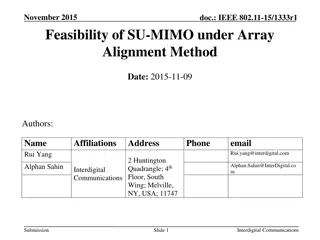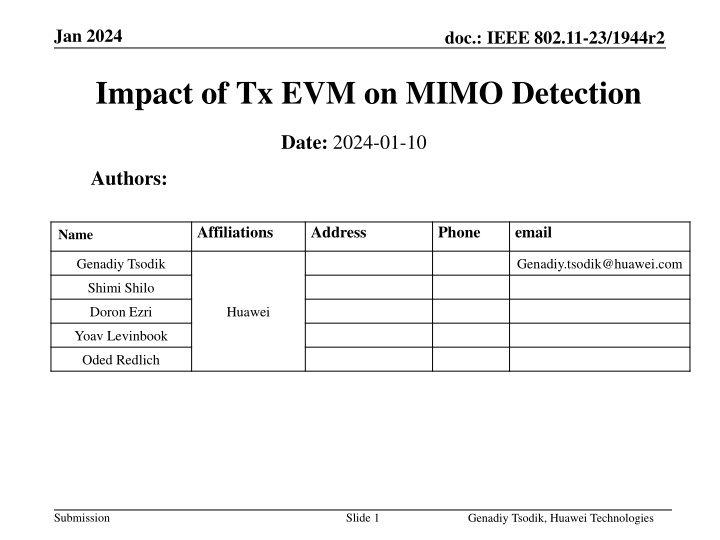
Impact of Tx EVM on MIMO Detection in WLAN Systems
Explore the impact of transmit error vector magnitude (Tx EVM) on MIMO detection in wireless systems, specifically WLAN. Understand the challenges of nonlinear detection in the presence of RF impairments and how it affects performance compared to linear detection. Discover the expected gains of a nonlinear decoder in MIMO transmissions and the practical scenarios where RF impairments influence detection outcomes. Gain insights into optimizing Tx EVM for improved MIMO performance in WLAN communication.
Download Presentation

Please find below an Image/Link to download the presentation.
The content on the website is provided AS IS for your information and personal use only. It may not be sold, licensed, or shared on other websites without obtaining consent from the author. If you encounter any issues during the download, it is possible that the publisher has removed the file from their server.
You are allowed to download the files provided on this website for personal or commercial use, subject to the condition that they are used lawfully. All files are the property of their respective owners.
The content on the website is provided AS IS for your information and personal use only. It may not be sold, licensed, or shared on other websites without obtaining consent from the author.
E N D
Presentation Transcript
Jan 2024 doc.: IEEE 802.11-23/1944r2 Impact of Tx EVM on MIMO Detection Date: 2024-01-10 Authors: Affiliations Address Phone email Name Genadiy Tsodik Genadiy.tsodik@huawei.com Shimi Shilo Doron Ezri Huawei Yoav Levinbook Oded Redlich Submission Slide 1 Genadiy Tsodik, Huawei Technologies
Jan 2024 doc.: IEEE 802.11-23/1944r2 Background MIMO techniques are widely used in wireless systems (e.g. WLAN) to achieve higher spectral efficiency and increase the throughput In order to exploit the maximum gain of MIMO transmissions, nonlinear (near ML) detection is often applied at the receiver side, as it significantly outperforms linear detection However, in practice nonlinear detection is sensitive to RF impairments and requires a higher Tx EVM in order to achieve the desired performance Strong impairments may have a significant impact on the performance of nonlinear detectors, such that in some cases linear detection outperforms nonlinear detection We look into this issue in order to understand what may be done to ensure WLAN receivers can employ near ML detectors to yield a large performance gain (as expected from theory) Submission Slide 2 Genadiy Tsodik, Huawei Technologies
Jan 2024 doc.: IEEE 802.11-23/1944r2 Expected Gain of Non-Linear Decoder We expect a significant gain that can be achieved by a nonlinear detector in case of MIMO transmission (MU or SU) It is clear that near-ML detection is much more complex, but one may consider this higher complexity worth the effort in order to achieve a significant performance improvement Submission Slide 3 Genadiy Tsodik, Huawei Technologies
Jan 2024 doc.: IEEE 802.11-23/1944r2 Practical Scenario In practice, RF impairments that cause a Tx EVM degradation lead to completely different results We simulated MIMO detection when we apply the OBO that needed to meet standard Tx EVM requirement (OBO = 7.4dB) MMSE outperforms ML! x-axis adjusted to SNR+OBO This misconception may make non-linear detection less attractive and prevents achieving higher efficiency in WLAN communication Submission Slide 4 Genadiy Tsodik, Huawei Technologies
Jan 2024 doc.: IEEE 802.11-23/1944r2 Tx EVM Impact on MIMO performance The spec mandates maximal Tx EVM per MCS for example you must have Tx EVM lower (better) than -27dB for MCS 7 How you get there (better RF, higher output back-off) is up to each vendor So let s try to analyze the impact of Tx EVM on MIMO detection s Let s assume for simplicity that instead of the transmitter transmits where and is the EVM power = + s s 2 w ( ) w I ~ CN 0, So the received signal with Tx EVM is = + = + + y Hs n Hs Hw n Colored noise... Submission Slide 5 Genadiy Tsodik, Huawei Technologies
Jan 2024 doc.: IEEE 802.11-23/1944r2 Short Proof of the Tx EVM Impact The Covariance of the colored noise is of course 2 * 2 = + C HH I C And the ML receiver for this model involves whitening with inverse Cholesky of ( ) ( ) * 1 = s y Hs C y Hs argmin ML M QAM s 2 2 When the Tx EVM component is more dominant, i.e. when we get ? QAM?? ?? ?2?? 1? ?? = argmin ? 1? ?2 ?ML= argmin ? QAM? So in this case the optimal (EVM-aware) MLD coincides with linear detection Submission Slide 6 Genadiy Tsodik, Huawei Technologies
Jan 2024 doc.: IEEE 802.11-23/1944r2 How can we resolve this issue? As we showed in the previous slide, the problem happens when the Tx EVM component is stronger than the white noise in the covariance of the colored noise 2 * = C HH 2 + I And we observed this issue when we used an OBO that meets standard Tx EVM requirements Following this understanding, we may assume that standard Tx EVM requirement better fits linear detection in case of MIMO transmission Thus, operating with OBO that meets standard Tx EVM requirement may limit MIMO performance when non-linear detection is employed So maybe we need to set OBO differently when near-ML detection is applied at the receiver? Submission Slide 7 Genadiy Tsodik, Huawei Technologies
Jan 2024 doc.: IEEE 802.11-23/1944r2 Simulation With Larger OBO We simulated the same scenarios, where we use a larger BO than that needed to meet standard Tx EVM requirements In particular we compared again the results of nonlinear detection with those of MMSE We can see that the impact of OBO on PER in case of MMSE detection is very small (although increasing OBO may improve MMSE as well) But near-ML is impacted significantly We can see that near ML detection outperforms MMSE detection by 6dB (including consideration of the reduced power due to higher BO) Submission Slide 8 Genadiy Tsodik, Huawei Technologies
Jan 2024 doc.: IEEE 802.11-23/1944r2 Summary While in theory nonlinear MIMO detection is superior to linear detection, in practice it suffers from the impact of RF impairments An additional Tx EVM improvement of 1-2dB may result in PER gain of many dBs for a MIMO transmission (e.g. 6dB gain as shown on the previous slide) We may significantly improve performance if we adjust the Tx EVM for the specific MIMO scheme and the detector type being employed by the receiver Submission Slide 9 Genadiy Tsodik, Huawei Technologies


